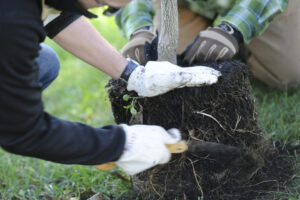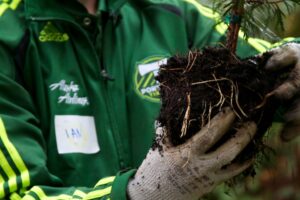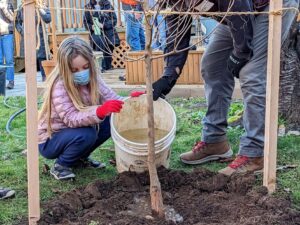Tag: roots
Leaflet
Restoring the Balance
Today, we’re asking you to put yourself in a tree’s shoes–or roots. Planting day is so exciting for volunteers. We get to hang out with our neighbors, get our hands dirty, and feel good about getting trees in the ground. But planting day is the most stressful day of a tree’s life.
When we plant a tree, we have to cut some of its roots. Container-grown trees need to have their roots cut to prevent them from circling in on themselves, even after they’re put in the ground. Ball and burlap trees are grown in the ground, but they also get their roots cut when they are put into that ball to be moved to their final location.

Trees are all about balance. Balance between canopy, where the tree can feed on sunlight and perform photosynthesis, and roots, which pull nutrients from the soil and provide the tree its needed strength and stability. For a newly planted tree, this time of year is all about restoring that balance and getting the roots and the shoots established.
Trees are like icebergs—there’s a lot more going on beneath the surface than we realize. Being able to understand what’s going on underground for our trees helps us better care for them, especially when it comes to watering.
We’ve mentioned watering plenty, but it’s so important that we can’t really talk about it too much. We have had an incredibly wet spring, which is great for the trees! As stewards, we’ve been able to keep our foot off the gas—we haven’t really had to worry about getting out our hose or watering bucket all that much.
But at some point the rain becomes intermittent and shallow enough that it doesn’t reach the tree roots. Watering trees is very different from watering grass, which benefits from frequent and shallow watering. One of the most common watering mistakes is watering your tree like you would your grass, for just a few minutes every day. For trees, we want deep and infrequent. In the summer, a thorough watering once a week is a perfect schedule (see details here).
When you water your tree, imagine what’s going on underground. We want to water the tips of the roots as they spread out. Another common watering mistake is when folks just point their hose at the base of the trunk and water there. You want to simulate a rain storm for your tree, watering all sides, and several feet away from the trunk so that you get the tips of the roots.
Overwatering is rare, but you still want to avoid it. Again, it helps to picture what’s going on beneath the surface. Perfect soil is about 50% air and water pockets. Too much water can flatten those pockets and there’s no air. You’re essentially drowning your roots. Beyond that, too wet soil threatens the stability of the tree. When a tree fails because it’s thrown by the wind, it’s usually because the soil is too wet.
This time of year, we are spectacularly rewarded for our care for our trees. Bud break, flowering, leafing out—it’s a rejuvenating thing to see each spring.
If you’re thinking about getting a new tree for your yard next year, now is a good time to consider which species you might want! What trees are catching your eye? What looks like it might be right at home in your yard. Take note now, and next year, we can get you what you’re looking for!
Leaflet: It’s Time To Put Down Some Roots

Last month, we told you why you should leave the leaves. We got such great feedback that we decided to create a regular tree care column, Leaflet, so that our eager experts can pass on their knowledge. We’ll share best practices for tree care and maintenance, explore common myths and misconceptions, and dig into the science behind it all.
“Now that the leaves are on the ground, we get busy,” says Neighborhood Trees Senior Specialist Drew Land about the November tree planting season. “Speaking of busy, roots are always busy.” We plant trees now so that while the trees are dormant above ground, they can focus on establishing their roots below ground. From timing to mulching to watering, our strategies help shape the tree’s root system.
“Street trees are not truly part of the urban forest until their roots start to intermingle,” Drew says. That’s why making sure a tree’s roots get established properly is a crucial part of planting and maintenance.
Because roots are almost entirely underground, we don’t really think about the shape of their structure. Rather than just a main tap root that goes straight down, 85% of a tree’s roots are within the top 24 inches of soil, or at least they should be. In the urban environment, roots are often up against the challenge of compacted and nutrient-depleted soil. In situations like these, roots will be too shallow, because they don’t have the space to seek out water and oxygen. Trees in the forest enjoy uncompacted soil with plenty of air and water spaces below ground. This also gives room for the fungal and microbial activity that brings soil to life.
“Roots are opportunists,” Drew says. “They follow the resources.” Given the right moisture and temperature, tree roots can grow year round. Insulation from mulch maintains those conditions, and we spread it in a way that encourages the roots to grow outward. Similarly, we shouldn’t just water at the base of a tree’s trunk, but should aim to water the tips of roots as they grow outward from the trunk. And we should water long enough that it sinks beyond the surface. Deep, infrequent watering mimics natural rain storms and gives roots what they need to spread both outward and downward. “Well-meaning people often shallow water on a daily basis, but that only feeds grass/weeds and not the tree roots a foot below. “
Tree roots come in two main types: structural roots and feeder roots. Structural roots are woody, and serve as the architecture to keep the tree upright. Feeder roots, which are much more like root hairs, are in charge of absorbing water and nutrients.

Maybe you have heard the myth that tree roots can grow into your sewer or water pipes and bust them open. Drew is here to officially bust that myth. He says that while roots are opportunistic, they are not invasive. “So the roots are not busting your sewer line,” he promises. “Your line is already busted and the roots found a tasty water source.”
Recreating ideal natural conditions is the best way to ensure that the roots of our urban trees stay healthy. “Roots are like muscles,” Drew says. “They grow in response to stress.” When you tie a newly planted tree too tightly to a support, it won’t have the freedom to move in the wind, building up those root “muscles” to support itself.
Getting the roots established is one of the most important reasons we plant new trees in the fall. “Planting trees now, while they’re dormant, will build their resilience,” Drew says. ”In ten months, when autumn winds hit their leaves for the first time, they’ll be ready.”
Further reading:
- “Roots Demystified” by Robert Kourik
- “Up by Roots” by Jim Urban

